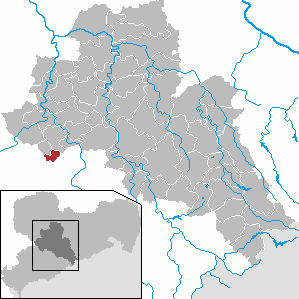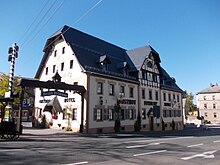Hartmannsdorf (near Chemnitz)
| coat of arms | Germany map | |
|---|---|---|

|
Coordinates: 50 ° 53 ' N , 12 ° 48' E |
|
| Basic data | ||
| State : | Saxony | |
| County : | Central Saxony | |
| Height : | 318 m above sea level NHN | |
| Area : | 10.28 km 2 | |
| Residents: | 4493 (Dec. 31, 2019) | |
| Population density : | 437 inhabitants per km 2 | |
| Postal code : | 09232 | |
| Area code : | 03722 | |
| License plate : | FG, BED, DL, FLÖ, HC, MW, RL | |
| Community key : | 14 5 22 260 | |
| Address of the municipal administration: |
Untere Hauptstr. 111 09232 Hartmannsdorf |
|
| Website : | ||
| Mayor : | Uwe Weinert ( CDU ) | |
| Location of the municipality of Hartmannsdorf in the district of central Saxony | ||
Hartmannsdorf is an industrial community in the district of Central Saxony near Chemnitz in the Free State of Saxony .
geography
Hartmannsdorf is located in the central Saxon hill country between the Leipzig lowland bay in the north and the Erzgebirge basin in the south (the border is the ridge of the Totenstein) on an agriculturally used plateau with fertile loess loam soils between the deeply cut river valleys of the Chemnitz in the east and the wooded steep banks of the Zwickauer Mulde in the West.
The community between Limbach-Oberfrohna , Mühlau and Burgstädt borders directly on the north-western areas of the city of Chemnitz .
history
Exact evidence of the founding of Hartmannsdorf cannot be provided, but it is likely to date back to the second half of the 12th century. At that time, with the establishment of castles and monasteries, settlers from Rhine and Main Franconia came to the area via Thuringia . It is believed that a locator named Hartmann, who gave Hartmannsdorf its name, was assigned the upper reaches of the Brausebach , which flows through Hartmannsdorf, as a settlement area in the 12th century through the castles Zinnberg or Drachenfels . The first documentary mention of a village is determined as the year of foundation, and this is for Hartmannsdorf in 1346 in a register (tax list) of the diocese of Meißen, which is kept as a copy in the cathedral monastery archive in Bautzen .
For centuries, rural life shaped what happened in the village, with craftsmen such as blacksmiths, woodworking craftsmen and millers gradually settling in, offering services that were important for the farmers.
The location of the village on the centuries-old connecting route between Chemnitz and Leipzig brought both positive and negative effects. The heavy traffic of horse-drawn carts that were on the way for traders opened up sources of sideline income for the village's farmers, which resulted from the wear and tear of horses or horse trade and from pre-tensioning services for overcoming the Chemnitz mountain for fully loaded wagons. The situation of the village had a negative effect in times of war. During the Thirty Years' War , Hartmannsdorf was ravaged by the plague in addition to looting and pillage. During the Northern War , the Second Silesian War , the Seven Years War and the Battle of Nations , the place was affected by billeting and marches.
Industrial development began in Hartmannsdorf as in the surrounding towns in the 18th century. When the Peniger hosiery guild was founded in 1750, ten Hartmannsdorf masters joined it. Almost a century later, large factory buildings were built in Hartmannsdorf, the first in 1846 by the Moritz Voigt and Kaiser company (fabric gloves), which employed the previous stocking workers and their family members as workers and many women as homeworkers. The fabric glove industry also allowed dyeing, bleaching and finishing plants to flourish. Due to the high demand for machines, the first larger machine factory, the Wirth company, was established in 1870.
The rapid industrial and commercial development transformed the agricultural character of Hartmannsdorf into a factory town and allowed the population to more than triple in 50 years (1840 = 1543/1890 = 5066).
The Hartmannsdorf Volunteer Fire Brigade was founded in 1866 , and in 1872 the Hartmannsdorf Gas Lighting Corporation received approval to build a gas station. In 1887 gas lighting was introduced throughout the village. In 1873 Hartmannsdorf was connected to the Limbach – Wittgensdorf railway line . 1882–1907 the village stream was arched. The new church was consecrated in 1894.
In 1905 the power supply in Hartmannsdorf was taken over by the electricity works in Oberlungwitz . In 1906 the first Saxon bus line Limbach - Mittweida via Hartmannsdorf was opened. The Hartmannsdorf natural pool was opened in 1914/1915.
The First World War cost the village 239 dead.
In 1919 the waterworks was put into operation to supply the village with good drinking water from its own well. In 1927 the construction of a sewage disposal system (Mannsbachschleuse), the construction of the Recenia and the incorporation of Kühnhaide from Göppersdorf began. In 1931 the development work on the Goethe settlement began, and in 1932 the Kühnhaide settlement was founded.
In addition to the many factories in Hartmannsdorf, there was a dense network of small handicrafts, trades and businesses. Among other things, 23 restaurants and pastry shops are listed in the address book in 1929, of which the Hotel "Kronprinz" and the Gasthof "Stadt Chemnitz" had a larger dance hall, 18 tailors, 14 bakers, 12 shoemakers, 11 hairdressers, 8 gardeners, 7 Butchers, 30 grocery stores (including 2 consumer outlets), 7 cigar, cigarette and tobacco dealers, 6 motor and bicycle shops, 4 chocolate shops, 3 watchmaker shops, 3 gallantry shops, 2 oil and soap wholesalers, 2 yarn and silk shops and 7 trucking shops. There were also 38 associations and interest groups.
During the Second World War, there was a Wehrmacht prisoner-of-war camp in Hartmannsdorf , the IV F main camp . From 1941 to 1945 around 50,000 prisoners of war were distributed from here for forced labor in the surrounding area. Among others it was the Aceso-Werk Alois Cerny & Söhne KG , which accepted armaments orders in wartime and employed slave labor.
The Second World War ended for Hartmannsdorf on April 14, 1945 after little resistance with the entry of American motorized and armored troops, where one person was killed, some barns went up in flames and a meter high flame burned from the gas tank of the gas works. The withdrawing Americans were followed by the Red Army , whose occupation lasted until 1949. Hartmannsdorf suffered 529 deaths in the Second World War, and the dismantling of the machines in the larger companies almost brought the economy to a standstill.
After the founding of the GDR in 1949, the economy slowly recovered, which was particularly evident in Hartmannsdorf in the traditional textile sectors, in mechanical engineering and in an electronics company.
In 1965 the roof of the church burned down and the reconstruction took several years.
After the end of the GDR, industry was only partially competitive in the free market economy and almost completely collapsed.
In 1993 the new municipal council decided in one of its first meetings to create an industrial area in Hartmannsdorf with a total size of approx. 65 hectares on Burgstädter Straße. By May 1994, all areas had been sold.
Memorials
- Memorial stone on Elzingmarkt in memory of Nazi opponents Max Tennler and Arno Förster , who were murdered by SS men on Elzteich in 1933 .
- Memorial stone with information board on the property at Ziegelstrasse 1 in memory of 50,000 forced laborers who passed through the prisoner-of-war camp Stalag IV F from 1941 to 1945 .
politics
Municipal council
Since the municipal council election on May 26, 2019, the 16 seats of the city council have been distributed among the individual groups as follows:
- CDU : 8 seats
- Citizens' initiative for Hartmannsdorf (non-party) e. V. (BfH): 5 seats
- Alternative for Germany (AfD) 2 seats
- LEFT : 1 seat
mayor
Uwe Weinert was confirmed in office in January 2015.
Local partnerships
Hartmannsdorf has had a local partnership with the Baden-Württemberg community of Schönaich since 1990 .
Culture and sights
museum
- Saxon Commercial Vehicle Museum
music
- Shawm guild Hartmannsdorf eV
- Young Life e. V. - Brass music from Hartmannsdorf
leisure
- Shooting Society Hartmannsdorf eV
Economy and Infrastructure
traffic
With the extension of the A 72, Hartmannsdorf will have a direct motorway connection. Since the opening of the A 72, the B 95 in Hartmannsdorf is no longer a federal highway. The Hartmannsdorf stop (near Chemnitz) was on the Limbach – Wittgensdorf railway line .
Healthcare
The DIAKOMED - Diakoniekrankenhaus Chemnitzer Land (sponsor: DIAKOMED gGmbH) is a regular provider .
Local businesses
- Komsa Kommunikation Sachsen AG
- Diamant Fahrradwerke AG
- REGIOBUS Mittelachsen GmbH
- Hartmannsdorf Brewery
- SLG Testing and Certification GmbH
- Emil Wirth Maschinenbau GmbH (founded 1870)
- ELCON Systemtechnik GmbH
- Agricultural Engineering Center (LTZ) Chemnitz GmbH
- KcK small container service copper
- Tire service Mainz GmbH & Co.KG
- w-support.com GmbH
- Schmaus GmbH
Personalities
- Werner Schmidt-Hammer (1894–1962), Lieutenant General, holder of the Knight's Cross
- Karl-Heinz Claus (1920–2005), marketing director and specialist book author
- Roland Mayer (1927–2013), chemist and university professor
- Christoph Richter (* 1942), politician
- Gunnar Grosse, Komsa founder, honorary citizen of Hartmannsdorf
literature
- Richard Steche : Hartmannsdorf. In: Descriptive representation of the older architectural and art monuments of the Kingdom of Saxony. 14th booklet: Amtshauptmannschaft Rochlitz . CC Meinhold, Dresden 1890, p. 14.
- The district of Chemnitz in historical views. Geiger Verlag Horb am Neckar, 1992, ISBN 3-89264-730-5 (on the history of the places in the former Chemnitz district : Hartmannsdorf pp. 104-107)
Web links
- Atlas Central Saxony
- official website of the Hartmannsdorf community
- Community information
- Hartmannsdorf in the Digital Historical Directory of Saxony
Individual evidence
- ↑ Population of the Free State of Saxony by municipalities on December 31, 2019 ( help on this ).
- ↑ a b Rita Türpe (with effi): Memorial plaque to commemorate 50,000 prisoners of war In: Freie Presse . August 26, 2012
- ↑ Hartmannsdorfer Maschinenfabrik and predecessor . In: Staatsarchiv Chemnitz ( Memento of the original from June 26, 2008 in the Internet Archive ) Info: The archive link was inserted automatically and has not yet been checked. Please check the original and archive link according to the instructions and then remove this notice. , last accessed March 4, 2010.
- ↑ Results of the 2014 municipal council elections
- ↑ Result of the election for the municipal council on May 26, 2019 | Hartmannsdorf community. Retrieved August 19, 2019 .
- ↑ https://www.statistik.sachsen.de/wpr_alt/pkg_s10_bmlr.prc_erg_bm?p_bz_bzid=BM151&p_ebene=GE&p_ort=14522260







